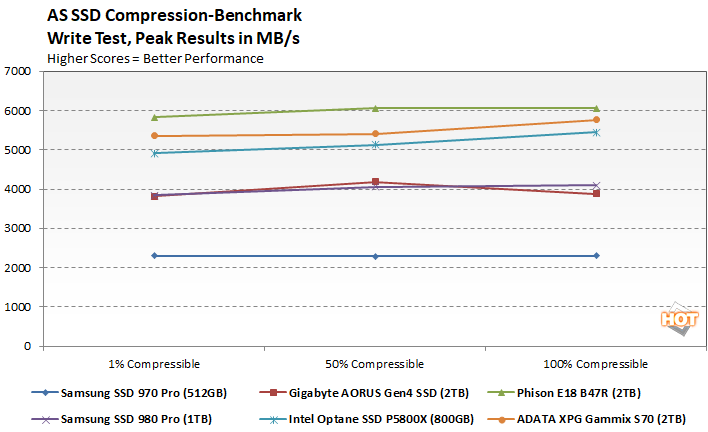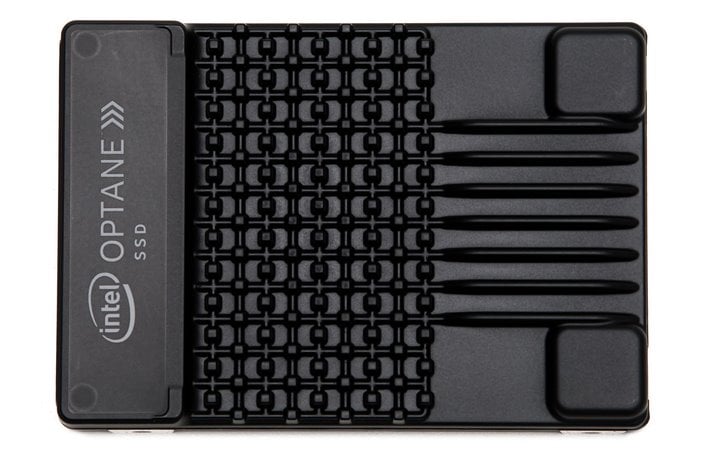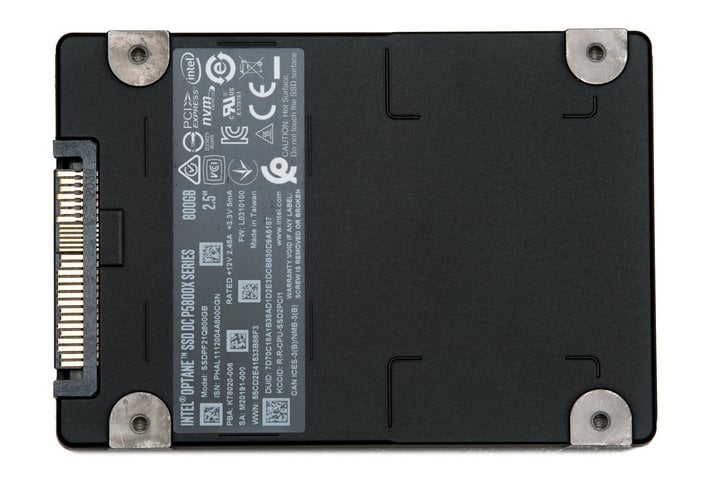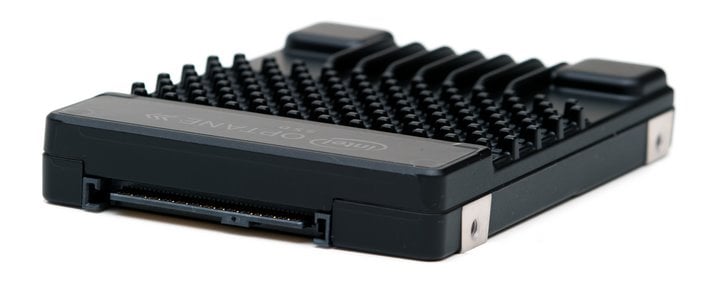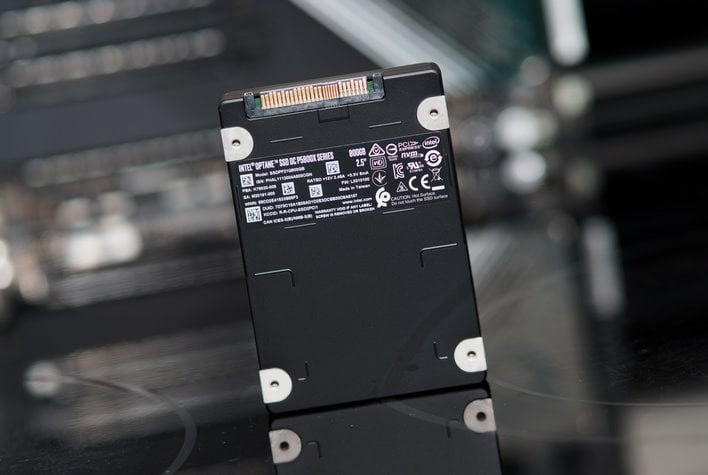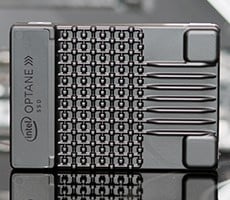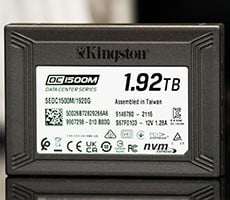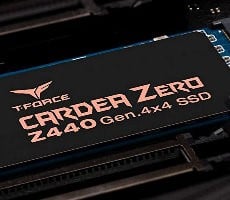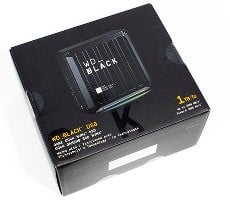Intel Optane SSD P5800X Review: The Fastest SSD Ever
Intel has previously called the Optane SSD P5800X the “world’s fastest data center SSD”. That data center designation usually meant drives were destined only for big-iron servers and enterprise customers. As of now though, Intel is also repositioning the Optane SSD P5800X as the ultimate SSDs for workstation users and by extension performance-hungry enthusiasts. The drives will be offered through system partners and traditional retail channels, so if you’ve got the funds, you won’t have to jump through hoops to obtain one.
We suggest pausing here for a moment to hide your credit cards and lock your PayPal accounts for at least 24 hours. When you see some of the forthcoming benchmarks, there’s a strong possibility you’ll be lusting after the Optane SSD P5800X, and may make a rash decision – the kind that may land you in hot water with the spouse or force you to eat nothing but expired ramen for a few months. But we’re getting ahead of ourselves. There’s lot of technical stuff to cover first, so let’s get to it...
Intel Optane SSD P5800X: Specifications And Features

If you jumped right to the throughput numbers in the spec table above, you may have missed a couple of important details, first and foremost being the Optane SSD P5800X’s endurance rating. Intel rates the P5800X for 100 drive writes per day – yes, 100 – as in 100X higher (or more) endurance than many of the latest NAND-based enterprise SSDs. The Optane SSD P5800X also offers 4K random reads at a queue depth of 1 with latencies approaching the nanosecond scale. These drives essentially respond faster than any competing solution on the market and it would take an otherworldly, sustained beating to wear one out.
Sequential reads and writes of approximately 7.4GB/s are also excellent, but not out of line with other top-end PCIe Gen 4 SSDs of today. Peak random IOPs in the 1.55 – 2M range are quite strong as well.
All of that killer performance and endurance is made possible by few things. First, these drives are based on a proprietary PCIe Gen 4x4 native controller and they feature Intel’s second-generation Optane media. The controller is specifically designed to exploit the 3DXpoint memory technology under the hood and the second-gen, 4-layer Optane media significantly improves IO performance over its 2-layer, first-gen predecessor. The Optane SSD P5800X’s firmware is also tuned to maximize performance and maintain a consistent QoS at low queue depths, and Intel continues to develop its own NVMe driver, which offers better performance than the generic drivers baked into Windows.
The Intel Optane SSD P5800X we’ll be showing you here has a black, anodized enclosure, with heatsink-fins built into the design. The drives leverage the U.2 2.5” x 15mm form factor and will be offered in capacities ranging from 400GB all the way on up to 1.6B – we’ve got an 800GB drive on tap for you here. To use one of these drives, you’ll need a U.2 port on your motherboard or will have to purchase a PCIe Gen 4-ready U.2-to-PCI Express adapter card. We tested the Optane SSD P5800X in just such an adapter card and it performed flawlessly.
We should also note that the drives carry a full 5-year warranty, as has become the norm with high-end SSDs. And with all of that out of the way, let’s get to some numbers.
Intel Optane SSD P5800X Benchmarks
Under each test condition, the SSDs showcased here were installed as secondary volumes in our testbed, with a separate drive used for the OS and benchmark installations. Our testbed's motherboard was updated with the latest BIOS available at the time of publication and Windows was fully updated. Windows firewall, automatic updates, and screen savers were all disabled before testing and Windows 10 Quiet Hours / Focus Assist was enabled to prevent any interruptions.
In all test runs, we rebooted the system, ensured all temp and prefetch data was purged, waited several minutes for drive activity to settle and for the system to reach an idle state before invoking a test. All of the drives here have also been updated to their latest firmware and their proprietary NVMe drives were used where applicable.HotHardware's Test System:
| Processor: AMD Threadripper 3990X Motherboard: MSI TRX40 Creator (TRX40 Chipset) Video Card: GeForce RTX 2080 Ti Memory: 32GB G.SKILL DDR4-3200 Storage: Corsair MP600 (OS Drive) Samsung SSD 980 Pro (1TB) Gigabyte Aorus NVMe PCIe 4 (2TB) Samsung SSD 980 Pro (1TB) ADATA XPG GAMMIX S70 (2TB) Phison E18 w/ B47R (2TB) Intel Optane SSD P5800X (800GB) |
OS: Windows 10 Pro x64 Chipset Drivers: AMD v2.07.14.327 Benchmarks: IOMeter HD Tune v5.75 ATTO v4.01.0f AS SSD SiSoftware SANDRA CrystalDiskMark v7 x64 CrystalDiskMark v8 x64 PCMark 10 Quick Storage Bench |
IOMeter Benchmarks
Though IOMeter is a well-respected industry standard benchmark, the fact of the matter is, though our results with IOMeter scale, it is debatable as to whether or not certain access patterns actually provide a valid example of real-world performance. The access patterns we tested may not reflect your particular workload, for example. That said, we do think IOMeter is a reliable gauge for relative throughput, latency, and bandwidth with a given storage solution. In addition, there are certain highly-strenuous workloads you can place on a drive with IOMeter, that you can't with most other storage benchmark tools.In the following tables, we're showing two sets of access patterns; a custom Workstation pattern, with an 8K transfer size, consisting of 80% reads (20% writes) and 80% random (20% sequential) access and a 4K access pattern with a 4K transfer size, comprised of 67% reads (33% writes) and 100% random access. Queue depths from 1 to 32 were tested...
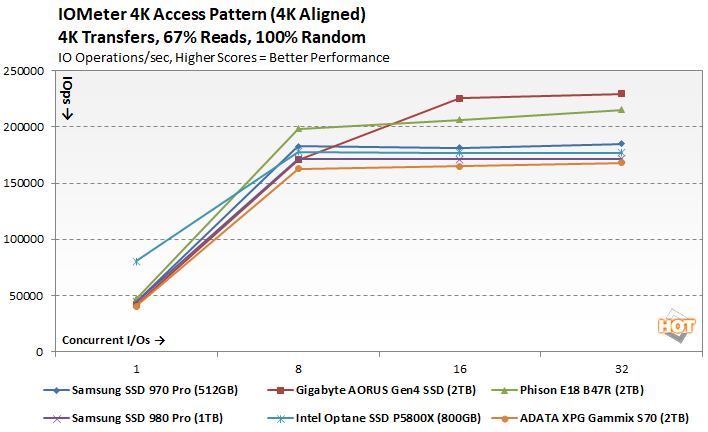
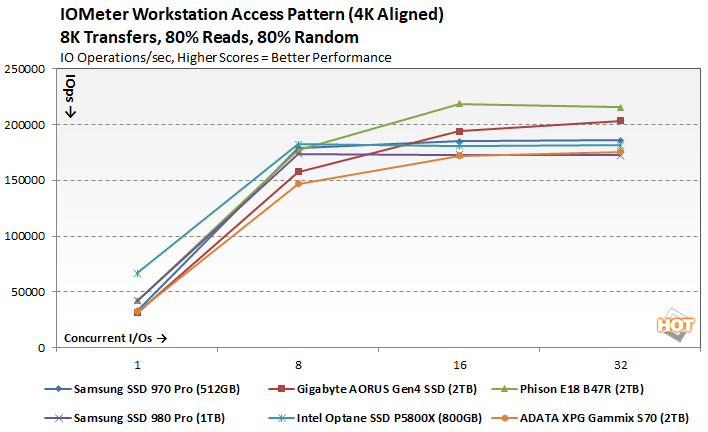
With both of the access patterns we tested, the Intel Optane SSD P5800X clearly outran all of the other drives we tested at QD1 and remained in the mix up to QD8. At the higher queue depths, the Phison-based drives pulled ahead, but the Optane SSD P5800X remained competitive throughout.
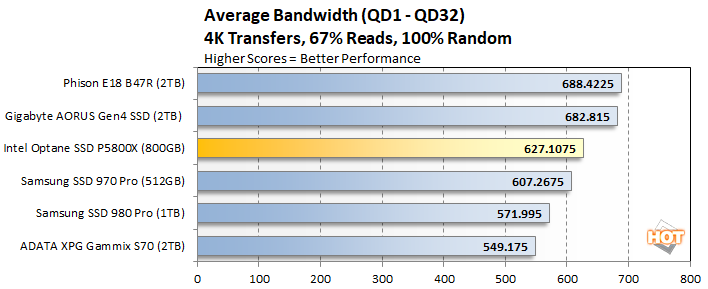
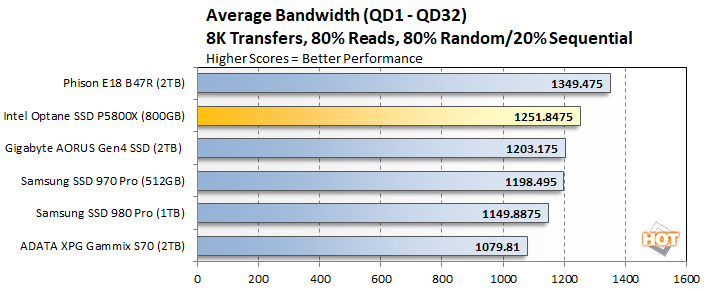
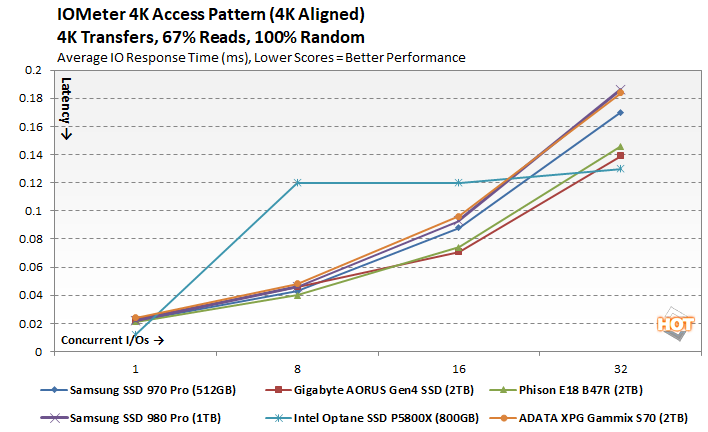
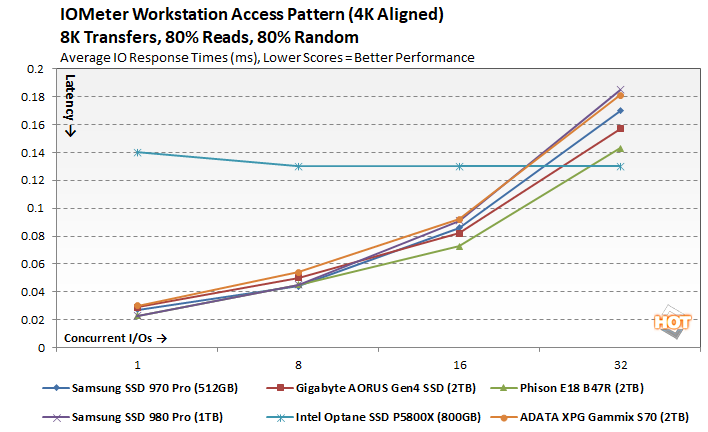
Our latency results clearly illustrate how the Optane SSD P5800X is optimized. The 800GB drive we tested clearly offered the best latency at QD1 with the 4K, 100% random access pattern. At the higher queue depths, and with the larger access pattern, however, the drive's latency characteristics aren't nearly as good.
SiSoft SANDRA 2021

The SANDRA file system benchmark shows the Optane SSD P5800X trading victories with the Phison E18-based drive that featured Micron B47R NAND. The Phison drive's overall score is higher, due to its better average write performance, but the Optane SSD P5800X offered slightly better reads.
ATTO Disk Benchmark
ATTO is another "quick and dirty" type of disk benchmark that measures transfer speeds across a specific volume length. It measures raw transfer rates for both reads and writes and graphs them out in an easily interpreted chart. We chose .5KB through 64MB transfer sizes and a queue depth of 6 over a total max volume length of 256MB. ATTO's workloads are sequential in nature and measure raw bandwidth, rather than I/O response time, access latency, etc.

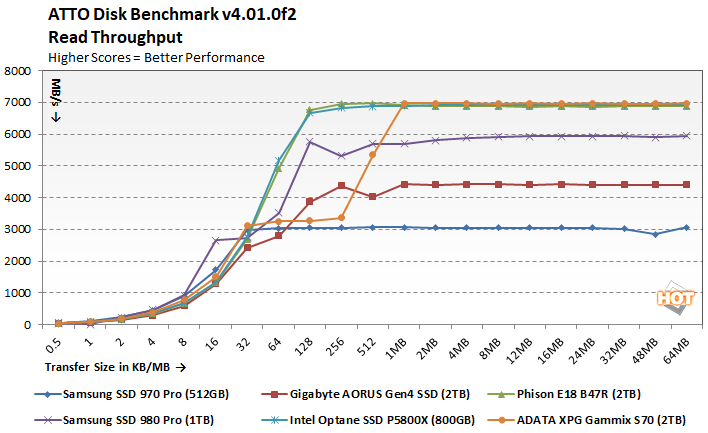
Write throughout with the Optane SSD P5800X once again trailed the Phison-based drives, but read performance is competitive with the fastest NAND-based SSDs on the market. The drives are effectively bumping into the limits of their interface here, hence the similar scores in the read tests at the top of the charts.
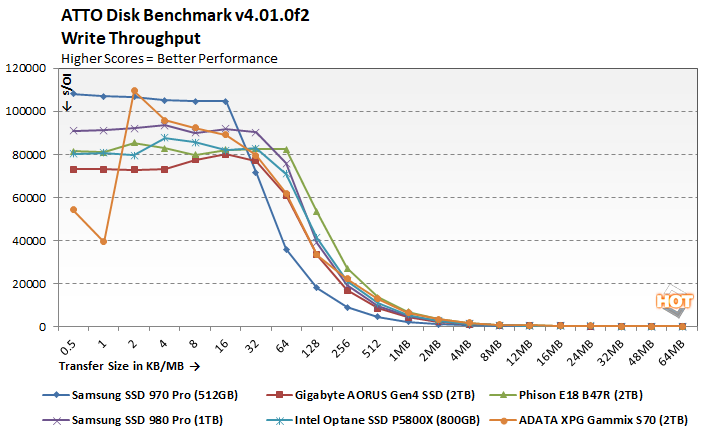
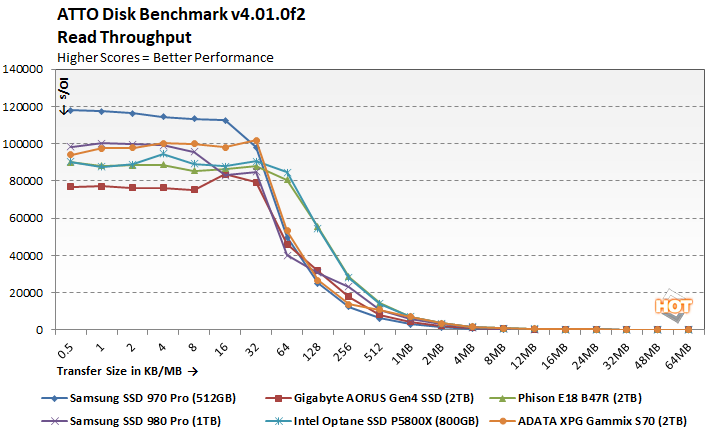
IO performance according to ATTO shows the Optane SSD P5800X landing about in the middle of the pack, but competitive with the other drives we tested throughout the tests.
AS SSD Compression Benchmark
Next up we ran the Compression Benchmark built-into AS SSD, an SSD specific benchmark being developed by Alex Intelligent Software. This test is interesting because it uses a mix of compressible and non-compressible data and outputs both Read and Write throughput of the drive. We only graphed a small fraction of the data (1% compressible, 50% compressible, and 100% compressible), but the trend is representative of the benchmark’s complete results.

